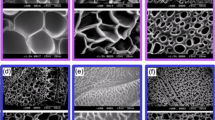Abstract
Nano-scaled particles were obtained from two different cellulose acetates, cellulose acetate propionate, and cellulose acetate butyrate using the emulsification solvent evaporation procedure and the low energy methods of solvent displacement (dialysis and controlled precipitation). The relationship between the formulation parameters and the particle properties were evaluated in case of the emulsification-evaporation technique. For the solvent displacement procedures, the influence of the formulation parameters, and the intrinsic polymer properties like the hydrophilic-hydrophobic balance was evaluated. Comparing the methods, it could be shown that large amounts of small and uniform nanoparticles can be obtained by the emulsification solvent evaporation procedure. The solvent displacement techniques turned out to be very easy to use and to yield narrowly distributed particles as well.




Similar content being viewed by others
References
Anton N, Benoit JP, Saulnier P (2008) Design and production of nanoparticles formulated from nano-emulsion templates: a review. J Controlled Release 128(3):185–199
Aubry J, Ganachaud F, Addad JPC, Cabane B (2009) Nanoprecipitation of polymethylmethacrylate by solvent shifting: 1. boundaries. Langmuir 25(4):1970–1979
Boddohi S, Kipper MJ (2010) Engineering nanoassemblies of polysaccharides. Adv Mater 22(28):2998–3016
Chronopoulou L, Fratoddi I, Palocci C, Venditti I, Russo MV (2009) Osmosis based method drives the self-assembly of polymeric chains into micro- and nanostructures. Langmuir 25(19):11940–11946
Daus S, Heinze T (2010) Xylan-based nanoparticles: prodrugs for ibuprofen release. Macromol Biosci 10:211–220
Edgar KJ (2007) Cellulose esters in drug delivery. Cellulose 14:49–64
Edgar KJ, Buchanan CM, Debenham JS, Rundquist PA, Seiler BD, Shelton MC, Tindall D (2001) Advances in cellulose ester performance and application. Prog Polym Sci 26:1605–1688
Fessi H, Puisieux F, Devissaguet J, Ammoury N, Benita S (1989) Nanocapsule formation by interfacial polymer deposition following solvent displacement. Int J Pharm 55(1):R1 – R4
Heinze T, Schaller J (2000) New water soluble cellulose esters synthesized by an effective acylation procedure. Macromol Chem Phys 201:1214–1218
Heinze T, Michealis N, Hornig S (2007) Reactive polymeric nanoparticles based on unconventional dextran derivatives. Eur Polym J 43(3):697–703
Horn D, Rieger J (2001) Organic nanoparticles in the aqueous phase–theory, experiment, and use. Angew Chem Int Ed 40(23):4330–4361
Hornig S, Heinze T (2008) Efficient approach to design stable water-dispersible nanoparticles of hydrophobic cellulose esters. Biomacromolecules 9:1487–1492
Hornig S, Biskup C, Gräfe A, Wotschadlo J, Liebert T, Mohr GJ, Heinze T (2008) Biocompatible fluorescent nanoparticles for pH-sensoring. Soft Matter 4(6):1169–1172
Hornig S, Bunjes H, Heinze T (2009) Preparation and characterization of nanoparticles based on dextran-drug conjugates. J Colloid Interface Sci 338(1):56–62
Janes K, Calvo P, Alonso M (2001) Polysaccharide colloidal particles as delivery systems for macromolecules. Adv Drug Delivery Rev 47(1):83 – 97
Kulterer MR, Reischl M, Reichel VE, Hribernik S, Wu M, Köstler S, Kargl R, Ribitsch V (2011) Nanoprecipitation of cellulose acetate using solvent/nonsolvent mixtures as dispersive media. Colloids Surf A 375:23–29
Kulterer MR, Reichel VE, Kargl R, Köstler S, Sarbova V, Heinze T, Stana-Kleinschek K, Ribitsch V (2012) Functional polysaccharide composite nanoparticles from cellulose acetate and potential applications. Adv Funct Mater 22:1749–1758
Liu Z, Jiao Y, Wang Y, Zhou C, Zhang Z (2008) Polysaccharides-based nanoparticles as drug delivery systems. Adv Drug Delivery Rev 60(15):1650–1662
Peniche H, Peniche C (2011) Chitosan nanoparticles: a contribution to nanomedicine. Polym Int 60(6):883–889
Prabaharan M, Mano JF (2005) Chitosan-based particles as controlled drug delivery systems. Drug Deliv 12(1):41–57
Schittenhelm N, Kulicke WM (2000) Producing homologous series of molar masses for establishing structure-property relationships with the aid of ultrasonic degradation. Macromol Chem Phys 201(15):1976–1984
Schubert S, Delaney JT, Schubert US (2011) Nanoprecipitation and nanoformulation of polymers: from history to powerful possibilities beyond poly(lactic acid). Soft Matter 7(5):1581–1588
Sinha VR, Singla AK, Wadhawan S, Kaushik R, Kumria R, Bansal K, Dhawan S (2004) Chitosan microspheres as a potential carrier for drugs. Int J Pharm 274(1-2):1–33
Stubbs JM, Sundberg DC (2004) Nonequilibrium particle morphology development in seeded emulsion polymerization. iii. effect of initiator end groups. J Appl Polym Sci 91(3):1538–1551
Walstra P (1993) Principles of emulsion formation. Chem Eng Sci 48(2):333–349
Wondraczek H, Heinze T (2008) Efficient synthesis and characterization of new photoactive dextran esters showing nanosphere formation. Macromol Biosci 8:606–614
Acknowledgments
Finnish Funding Agency for Technology and Innovation (Tekes), Thuringian Ministry for Education, Science and Culture (grant #B514-09051, NanoConSens) and the Thuringian development bank (grant #2008 FE 9183] are acknowledged for funding. The authors thank Manuela Kötteritzsch, Peggy Laudeley, Katrin Otto and Franziska Busch for their technical assistance.
Author information
Authors and Affiliations
Corresponding author
Additional information
Member of the European Polysaccharide Network of Excellence (EPNOE), http://www.epnoe.eu.
Rights and permissions
About this article
Cite this article
Wondraczek, H., Petzold-Welcke, K., Fardim, P. et al. Nanoparticles from conventional cellulose esters: evaluation of preparation methods. Cellulose 20, 751–760 (2013). https://doi.org/10.1007/s10570-013-9874-x
Received:
Accepted:
Published:
Issue Date:
DOI: https://doi.org/10.1007/s10570-013-9874-x




